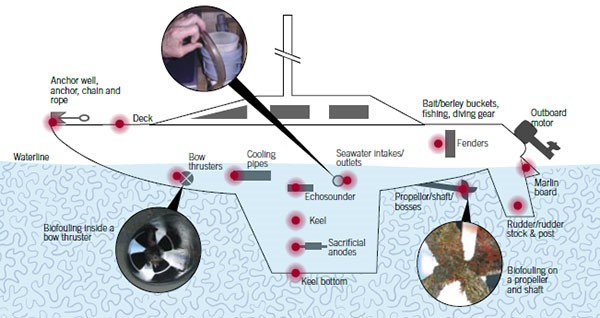Biofouling and ballast water – advice for vessel owners
Biofouling and ballast water can introduce new marine pest and disease impacts to Australia or spread them into SA waters from interstate.
Marine pests are virtually impossible to eradicate once established, as they are highly adaptable and multiply rapidly. Vessel owners must preserve our native species, marine environments, and primary industries by following cleaning guidelines and managing ballast water.
Biofouling
Biofouling, or fouling, is the accumulation of aquatic microorganisms, algae, plants and animals on vessel hulls and submerged surfaces.
Over 250 exotic marine organisms have been introduced into Australian waters by all types of vessels, from yachts to commercial ships. Up to 75 percent of these likely arrived as biofouling organisms, attached to the external and internal surfaces of vessels.
Biofouling guidelines
See the International Maritime Organization (IMO) biofouling guidelines for best-practise advice. The following national guidelines will also help you manage biofouling on your vessel or in your industry:
- anti-fouling and in-water cleaning
- recreational vessels
- aquaculture industry
- commercial vessels
- commercial fishing vessels
- non-trading vessels
- marinas, slipways, boat maintenance and recreational boating facilities
- petroleum production and exploration industry.
You should consistently maintain a biofouling management plan and record book as a measure to minimise biofouling. Refer to Appendix 2 of the Guidelines for the control and management of ships' biofouling to minimize the transfer of invasive aquatic species (PDF).
Ballast water
Ballast water is carried in a ship's ballast tanks to improve stability, balance, and trim. The water is taken up or discharged when cargo is unloaded and loaded, or when a ship needs extra stability in foul weather.
When ships take on ballast water, plants and animals that live in the ocean are also picked up. Discharging ballast water releases these organisms into new areas where they may become marine pests.
Biosecurity obligations
It is illegal to bring noxious species or notifiable aquatic pests and diseases into South Australia, including releasing or depositing exotic species into any waters. Offences exist under the Fisheries Management Act 2007 and Livestock Act 1997. Penalties may apply of up to $250,000 for a body corporate, and $120,000 for individuals.
The state’s Chief Veterinary Officer can order a vessel to be cleaned, or removed from state waters, if a notifiable disease is suspected or confirmed.
Obligations to manage ballast water and ballast tank sediment apply in all national waters, under Australian Government legislation and requirements.
Code of practice
South Australia’s Environment Protection Authority (EPA) has recommended practices for biofouling and ballast water: Code of practice for vessel and facility management (marine and inland waters).
The code assists users to comply with their environmental duty, outlined in the Environment Protection Act 1993 and related policies. It applies to people, organisations and agencies, including:
- persons that own, operate and use vessels
- vessel construction and maintenance facilities, such as slipways and launch facilities
- vessel storage facilities, within or adjacent to South Australian waters, such as:
- dry dock boat yards
- marinas
- moorings
- boat and yacht clubs.
Cleaning practices
Keeping your vessel clean prevents the introduction and spread of marine pests, which protects our marine and estuarine environments for future generations. It also benefits vessel owners with:
- increased vessel performance and speed
- reduced maintenance and running costs through lower fuel consumption
- extended life of vessel and gear.
Vessel and equipment cleaning
Follow these steps to look after your vessel and minimise biosecurity risks:
- Clean hulls before leaving for new destinations to reduce the risk of marine pests spreading to other areas.
- Regularly inspect and clean areas prone to biofouling. Check for pests on:
- boat hulls
- internal sea water systems
- anodes
- docking strips
- sea chests
- pipe openings
- propellers
- shafts and rudders.
- Apply suitable antifouling coating to the hull and cavities exposed to seawater and re-apply before the coating's lifespan expires. This is important for boats that remain in the water for extended periods.
- Clean and maintain your equipment, particularly before moving to a new area. Allow your boat 48 hours to dry and remove entangled seaweed and other organisms from:
- ropes
- anchors
- buoys
- fishing gear
- aquaculture equipment.
Read the Cleaning marine equipment factsheet ( ).
Vessel cleaning facilities in SA
In-water cleaning requirements
Removing vessels and structures from the water and cleaning them on land is the preferred approach to address biosecurity risks. If dry docking is not feasible, you can apply to undertake in-water cleaning.
Refer to the South Australian in-water cleaning guidelines ( ) which outlines:
- the requirements for in-water cleaning in SA while minimising the risks of introducing or spreading aquatic pests
- the grounds for permit application, including the risk-based assessment process
- how stakeholders can implement continual best practice biofouling management.
A permit authorising in-water cleaning will only be considered when you meet the biofouling removal standards set by the Department of Agriculture, Fisheries and Forestry (DAFF).

High risk areas to inspect on your vessel – image: Department of Agriculture and Water Resources